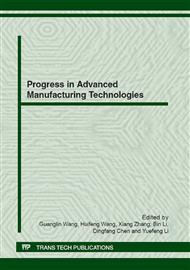p.364
p.369
p.373
p.378
p.383
p.388
p.396
p.400
p.406
Analysis of Unbalanced Response for Coupled Double-Rotor Spindle System of High Speed Grinder
Abstract:
This study was focused on the theoretical modeling and numerical simulation about the unbalanced response for coupled double-rotor spindle system of high speed grinder. Based on the rotor dynamics, a theoretical model was established using the transfer matrix method. The moment balance equations, and the transition matrix, the state vector, field matrix of coupled double-rotor spindle system of high speed grinder were analyzed and calculated. The numerical results showed that the amplitude of unbalance response increased by the same multiple as that of the amount of unbalance at different locations and at different speeds. Furthermore, the position most sensitive to the unbalance was the front end of rotor 2, followed by the middle and back end of rotor 2. Rotor 2 was especially sensitive to unbalance. Moreover, the vibration amplitudes of the front end, front and back bearings of rotor 1 increased in response to unbalanced increase of rotate speed. The vibration amplitude abruptly increased at 17500r/min corresponding to first-order critical speed.
Info:
Periodical:
Pages:
383-387
Citation:
Online since:
August 2012
Authors:
Price:
Сopyright:
© 2012 Trans Tech Publications Ltd. All Rights Reserved
Share:
Citation:


